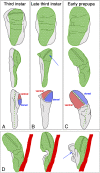Live imaging of Drosophila imaginal disc development
- PMID: 20660765
- PMCID: PMC2922528
- DOI: 10.1073/pnas.1008623107
Live imaging of Drosophila imaginal disc development
Abstract
Live imaging has revolutionized the analysis of developmental biology over the last few years. The ability to track in real time the dynamic processes that occur at tissue and cellular levels gives a much clearer view of development, and allows greater temporal resolution, than is possible with fixed tissue. Drosophila imaginal discs are a particularly important model of many aspects of development, but their small size and location inside the larva and pupa has prevented live imaging techniques from extensively being used in their study. Here, we introduce the use of viscous culture medium to enable high resolution imaging of imaginal disc development. As a proof of principle, we have analyzed the transformation that occurs during metamorphosis of the wing imaginal disc into the mature wing and report several previously unobserved stages of this model of organogenesis. These imaging methods are especially useful to study the complex and dynamic changes that occur during morphogenesis, but we show that they can also be used to analyze other developmental and cellular events. Moreover, our viscous medium creates a platform for future adaptation of other tissue culture conditions to allow imaging of a wide range of developmental events and systems.
Conflict of interest statement
The authors declare no conflict of interest.
Figures





References
-
- Bertet C, Sulak L, Lecuit T. Myosin-dependent junction remodelling controls planar cell intercalation and axis elongation. Nature. 2004;429:667–671. - PubMed
-
- Oda H, Tsukita S. Dynamic features of adherens junctions during Drosophila embryonic epithelial morphogenesis revealed by a Dalpha-catenin-GFP fusion protein. Dev Genes Evol. 1999;209:218–225. - PubMed
-
- Wood W, et al. Wound healing recapitulates morphogenesis in Drosophila embryos. Nat Cell Biol. 2002;4:907–912. - PubMed
-
- Ninov N, Martín-Blanco E. Live imaging of epidermal morphogenesis during the development of the adult abdominal epidermis of Drosophila. Nat Protoc. 2007;2:3074–3080. - PubMed
Publication types
MeSH terms
Substances
LinkOut - more resources
Full Text Sources
Molecular Biology Databases
Research Materials

